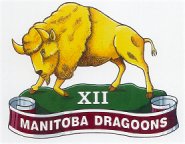

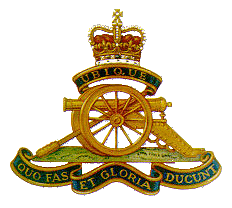 |
 |
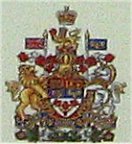 |
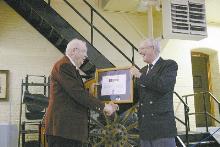 |
Maj. Gen. John Arch MacInnis presents Ross Neale with an RCA commendation for his leadership and dedication in developing the XII Manitoba Dragoon and 26 Field Regiment Museum. |
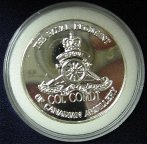 |
Brandon resident Ross Neale is a man whose dedication to the Canadian Armed Forces has lasted a lifetime. Deployed decades ago to serve his country overseas, Neale returned to the province, where he has dedicated 27 years to preserving the history of his brigade as the XII Manitoba Dragoon and 26 Field Regiment Museum curator.The XII Manitoba Dragoons and 26 Field Regiment Museum is an important part of Westman history. Housed within the century-old Brandon Armoury building, the museum is currently undergoing an extensive, three-year reorganization, overseen by Neale.
Last Thursday evening, the Royal Canadian Artillery formally recognized the commitment of this one man who has worked tirelessly over the years to collect, organize, and preserve artifacts from the 26 Field Regiment's history. Maj. Gen. (Ret.) John Arch MacInnis presented Neale with a Colonel Commandant Commendation from the RCA.
“The RCA is making a presentation to the museum, but that's only part of what we're doing today. In fact, I am making a presentation not to the museum, but to a man. A man who represents our heritage in this part of the gunner community; a man who was wounded in action; a man who came home and stayed with the infantry, and for the last 27 years, been the curator of the this museum,” said MacInnis.
MacInnis continued: "He's the epitome of what I believe to be an integral part of our heritage, which is not only the accumulation and preservation of artifacts, but the accumulation and preservation of the history of the unit and of the RCA. Mr. Neale exemplifies that sort of dedication to his unit and to our heritage."
Neale was presented with a plaque and a silver RCA coin for his service and dedication to the museum. Accepting his commendation, Neale described the recognition as "absolutely wonderful and unexpected."
"This is an unbelievable honour," said Neale.
The Colonel Commandant's Commendation
presented to
Mr. Ross Neale
Mr. Ross Neale is hereby commended for exceptional service and unselfish dedication to The Royal Regiment of Canadian Artillery through his development of the 26th Field Regiment XII Manitoba Dragoons Museum.His vision, leadership and hard work over a 27-year period, developped a museum of which all soldiers and veterans can be proud.
The museum with its associated gallery, library and archives has been instrumental in fostering awareness of the artillery and the militia in the local community.
Given under my hand
This the Third day of September, 2007
Major-General J. A. MacInnis, CMM, MSC, CD
Colonel Commandant.. 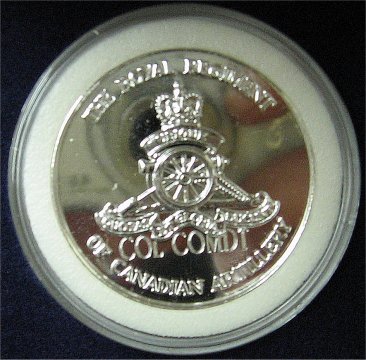
Click for full-screen image
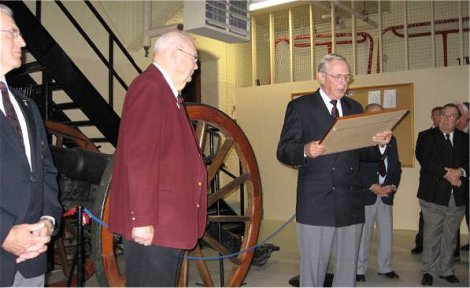 |
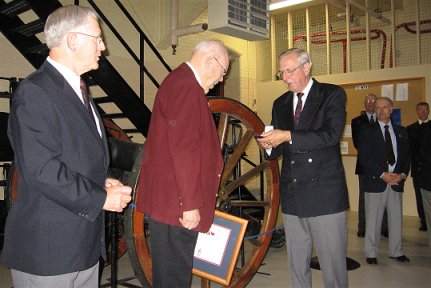 |
![]()
 |
Keeping local military history alive Feature Interview September 27, 2007 |
 |
Ross Neale stands with a favorite collection of artifacts in the XII Manitoba Dragoon and 26th Field Regiment Museum, located in the Brandon Armoury. A long-time member of the military himself,
|
Wheat City Journal: You're the curator for the 26th Field Regiment Museum. What is a typical day like for you?
Ross Neale: In the wintertime, we work all day every Tuesday. As a result of some fundraising, we have all new cupboards, so we're changing the way we operate. At present, we are working on these new cases, and trying to tell a story in each case.Journal: How did you come to be the curator?
Neale: Actually, a lot of the artifacts were from the XII Manitoba Dragoons, a regiment from Virden were in stores, and deteriorating, here at the Armoury. In 1976 I retired from the militia, and in 1978, the caretaker who lived on the third floor retired. The new caretaker didn't want to live in the caretaker's suite, so the two rooms that formerly belonged to the caretaker were set aside for a museum. All of the artifacts from the stores were brought up and put in that room. I was appointed curator to make something out of all of it. So I've been making and changing the museum ever since.Journal: Twenty-nine years is a long time! What is it about this job that keeps you captivated?
Neale: I guess the changes that we're making right now, and the fact that you can help people. People come in with questions, about family members for instance, for which they have no idea how to get the answers. Sometimes it's a puzzle, but we can usually find the answers.Journal: Are there any particular artifacts that you like to show to museum visitors? Or any favourite pieces?
Neale: We certainly do. Some years ago, a man was writing a book about the histories of different batteries. Batteries are the units that make up a regiment, and they each have their own history. So this man was going through records to write this book, and he started collecting a cap badge and a shoulder flash for each regiment involved in the Second World War. When it was all finished and the book was published, this man, who'd been a member of this regiment in 1945 and 1946, decided to give us his creation as a gift. He knew that I was at the museum, so one day he came with several long boxes, which he proceeded to unpack in the museum. He pulled out these displays he had made, and each one showed all of the cap badges and shoulder flashes for each corps and division, and all of the home defense people; everything is there, it's unbelievable. The displays together form a wheel that's now displayed in the museum.Journal: Do you think the museum plays a special role in the military?
Neale: We're forever asked by the regiment to give lectures on whatever they're studying or displays in the museum. We always make up quizzes for the battery here and in Portage, asking puzzling questions. This creates interest, so that they're forever coming to us for information on various things.Journal: You've also recently received a commandant's commendation for all of your hard work in the museum. What's it like to be given this honor by your peers?
Neale: This (commendation) was a complete surprise to me. When Colonel Berry was presenting the award, he talked about how much work has been done, and well, it has been a great deal of work. Everything will be changed in two or three years. After that, I'm sure it will change again. We'll have to take all of our displays apart and rebuild the museum. But basically, we try to tell a story in any display that we make. The boys from the regiment know we're here, and they come to see us, and we are asked to do things for them as well. The commendation itself was a really great honour.Journal: You've told me about your favorite artifact. Do you also have a favorite experience from working at the museum that really stands out in your memory?
Neale: There's quite a few. One of the big ones was about a bridge in the Netherlands. There was an overpass over a high-speed railway, and some people there wanted it named after the Canadian that was killed at that spot. One of the archivists over there knew it was one of the soldiers from the XII Manitoba Dragoons, but didn't know what his name was. So we were contacted, and we dug up all of the information that they wanted to know. Some of the townsfolk over there didn't believe the story about what had happened at this location, and they decided that they didn't want anything named after what they thought was a fictitious character. It was interesting because we were able to find the documents that were printed the day this man was killed, so we were able to show that the story was indeed true, and the bridge ended up being named after our soldier, after all. There's a bridge in the Netherlands that's now known as Ferguson Bridge. Gord (Sim, a colleague at the museum) went on the computer and found the soldier's sister, and she and her family went over there for the naming of the bridge. It was a really big affair, so that's one of lots of memories that really stands out.Journal: You said previously that you were involved with the militia. What was that part of your career like?
Neale: It was really varied. At the end of the war, I couldn't stay in the army as I'd been wounded in Normandy. I went to the Armouries in Minnedosa to see one of the officers, and there was a six-pounder, infantry anti-tank gun sitting on the floor. I asked what they were doing with it, and they responded that they didn't know what it was. I told them that I had qualified on it a couple of years ago, and they replied that I should come in and get that gun operational. So that was my start with the militia. I couldn't pass a medical exam, as I was still walking with a cane, but they did let me into the militia at the time. I spent five or six years with the Dragoons. Then in '53 I moved to Dauphin and spent five years there. From there, I moved to Strathclair and back to Dragoons. I never missed camp from 1946 to 1976.Journal: What originally motivated you to join the army?
Neale: Well, there was a war on, that was the primary reason. But after I returned from overseas, I chose to stay involved with the militia, and then with this museum.Journal: Do you have any hobbies or favorite pastimes, besides taking care of our local military history?
Neale: Number one is the museum. I do build model railroads in my basement, and I have grandchildren and great-grandchildren that I take great pride in.Journal: Did you have any family members who also served?
Neale: My dad was a regular force British soldier. When his regiment was in Egypt in 1911, he got malaria, and that was a ticket out of the army for him. He migrated to Canada just in time to enlist in the Canadian army. He was a British soldier for 11 years, and served with the Canadian forces after that for many years. After being wounded several times, including once at Vimy Ridge, he stayed with the militia as well, and in the thirties, got together an exercise team. Being involved with the military is really quite a family thing.Copyright ©2007 Wheat City Journal. All Rights Reserved

BACK TO CONTENTS PAGE
www.12mbdragoons.comXII MB Dragoons and 26 Field Regiment Site Design
by Webmaster: Bill Hillman
Visit the other Hillman Military Tributes at:
www.hillmanweb.com/warAll original contents Copyright © 2003-2011
Hillman Eclectic Studio